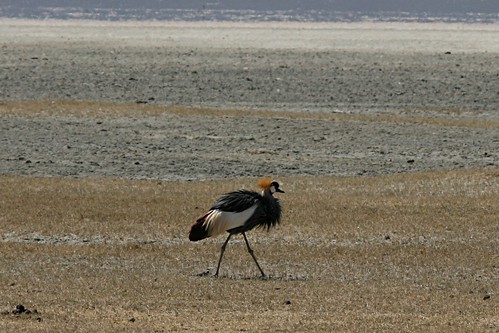What a haul from Serengeti!
First the marquee birds of Africa.
137.
Ostrich (
Struthio camelus)
This male was trying to woo his mate. He eventually went on to score.

138.
Secretary Bird (
Sagittarius serpentarius)
The theory is that this bird gets its name from the unique quills that make it look like a secretary of old with quill pens tucked behind his/her ears. Nas has a more sexist explanation, something do with long legs and mini-skirts that I don't completely buy.
 Starlings
Starlings
139.
Superb Starling (
Lamprotornis superbus)
This brightly coloured, gregarious bird doesn't seem to be afraid of people at all. They were present in all the picnic sites inside the national parks.

140.
Purple Glossy Starling (
Lamprotornis purpureus)
Another fairly common member of the starling family.

141.
Hildebrandt's Starling (
Lamprotornis hildebrandti)
Looks similar to the Superb Starling, but the red irises are a giveaway.
 Bustards
Bustards
142.
Kori Bustard (
Ardeotis kori)
Said to be the heaviest bird -average male weighs 12kgs-capable of flight.

143.
White-bellied Bustard (
Eupodotis senegalensis)
 Vultures
Vultures
144.
White-backed Vulture (
Gyps africanus)
The first bird on this roster that has a "Near Threatened" status.

145.
Hooded Vulture (
Necrosyrtes monachus)
Yet another old-world vulture. This one was waiting for a hyena to finish his mail so that it could then clean up the scraps.
 Raptors
Raptors
146.
African Pygmy-falcon (
Polihierax semitorquatus)
At a little over 19 cm, this is one of the smallest raptors I've seen.

147.
Eastern Chanting Goshawk (
Melierax poliopterus)
 Hornbills
Hornbills
148.
Von der Decken's Hornbill (
Tockus deckeni)

149.
Southern Ground-hornbills (
Bucorvinae leadbeateri)
Wish I could take a better picture of this ground dwelling hornbill. Its mate is blurred in the background.
 Weavers
Weavers
150.
Rufous-tailed Weaver (
Histurgops ruficaudus)
Yet another species that's comfortable around humans. This couple was shot in the Naabi hill inside Serengeti.

151.
Red-billed Buffalo-weaver (
Bubalornis niger)
Seemed to be picking something out of the big pile of elephant dung.

152.
White-headed Buffalo-weaver (
Dinemellia dinemelli)
This one was competing with the starlings in picking up scraps from the picnic area.
 Wader
Wader
153.
Spotted Thick-knee (
Burhinus capensis)

154.
Grey Heron (
Ardea cinerea)
One of the few birds I could recognize with any confidence.

155.
Blacksmith Lapwing or Blacksmith Plover (
Vanellus armatus)
Gets its name from its call which sounds like a blacksmith striking metal.

156.
Coqui Francolin (
Francolinus coqui)
I'm not very sure of this ID. Waiting for a friend to confirm it.

157.
Egyptian Goose (
Alopochen aegyptiacus)

158.
Temminck's Courser (
Cursorius temminckii)
Extremely doubtful of the ID.

159.
Crowned Lapwing (
Vanellus coronatus)
They inhabit this park in great numbers.

160.
Marabou Stork (
Leptoptilos crumeniferus)

161.
African Sacred Ibis (
Threskiornis aethiopicus)
Venerated in ancient Egypt as the symbol of the god Thoth.
 Other
Other
162.
Kenya Rufous Sparrow (
Passer rufocinctus)
Distinguishable from the house sparrow by the rufous coloration o its supercilium and around its ears.

163.
Ring-necked Dove (
Streptopelia capicola)

164.
Fischer's Lovebird (
Agapornis fischeri)
This bird, I think, deserves a better name.

165.
Fork-tailed Drongo (
Dicrurus adsimilis)
Very similar in appearance to the Black Drongo of our country.

166.
White-browed Coucal (
Centropus superciliosus)

167.
Chestnut-bellied Sandgrouse (
Pterocles exustus)

168.
Magpie Shrike (
Urolestes melanoleucus)

169.
Lilac-Breasted Roller (
Coracias caudatus)

170.
Little bee-eater (Merops pusillus)

171.
Helmeted Guineafowl (
Numida meleagris)
A fairly common bird in this part of the world. My guide, Nas, tells me that their meat is very tasty.

